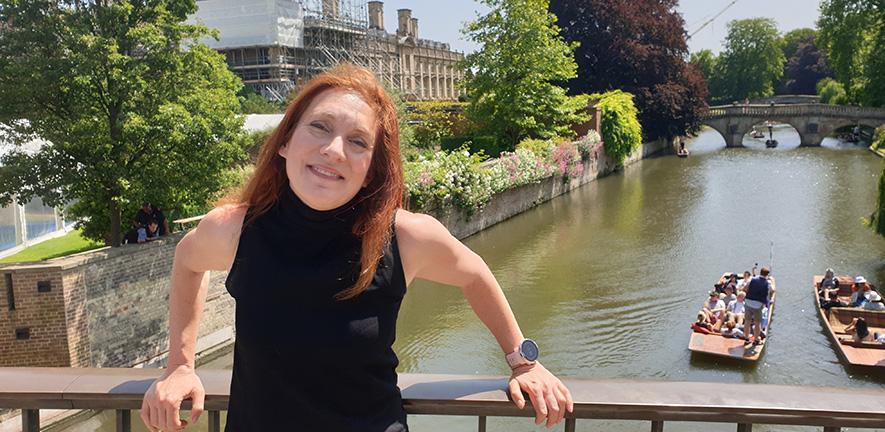Prof Helen Williams joined the Department of Earth Sciences in 2016 and is currently Professor of Geochemistry. She reflects on her life and work with Erin Martin-Jones.
Why are you interested in Earth’s interior?
What really fascinates me is how the chemistry of Earth’s interior has changed over time. The surface we live on is only a very tiny part of our planet: studying Earth’s mantle is important to answer questions like why our planet hosts life, or indeed why other planets might not. The compositions of gases that come out of volcanoes, the movement of plates, our magnetic field, the heat in our planet: in my eyes everything links back to our planet’s interior chemistry. My work focuses on this key theme, and I use isotopic evidence to unravel the processes going on.
You have previously described your work as ‘CSI in the past’ — why?
Ultimately I’m trying to use geochemical forensic evidence to piece together clues — reconstructing ancient conditions, deep in Earth’s interior — all whilst bridging big gaps in time and often very incomplete records. This means my work is very varied and detailed, sometimes involving fieldwork in places like Greenland, to carefully select rocks that I later analyze via mass spectrometry.
What are you currently working on?
Last year, I had some work published in Science Advances, reporting some of the first evidence for crystal remnants from the Earth’s early magma ocean in Greenland rocks. I’d had the thought when locating samples, ‘If I don’t find it here then I won’t find it anywhere…’Getting the data off the mass spectrometer and seeing the patterns — the moment I realized I’d finally found the evidence was amazing.

You are continuing your work on magma oceans?
I’m proud to say I’ve been awarded a European Research Council (ERC) Advanced Grant to expand this work, using sensitive isotopic tools to travel far back in time to Earth’s first 500 million years. The question of how Earth’s early magma oceans cooled and settled into the internal structure we have today is one of the most enduring questions in the geochemistry community.
What first got you interested in Earth Sciences?
I started out at Cambridge as a biological natural scientist and have always found the broad science training offered by the Natural Sciences degree very useful. My transition to Earth Sciences really happened by chance — a second year Earth scientist lent me her lecture notes in my first few days at Cambridge, and when I flipped through them I thought ‘this seems pretty interesting’… Then, when I heard there would be a field trip to Arran I was sold. Eventually I was hooked: I found I was devoting more and more time to my Earth Sciences classes and supervisions compared to my other subjects.
You organized a mapping expedition to Svalbard in your second year?
This was really the experience that made me think about research as a career. I wanted to get out there and prove something to myself. I was keen to travel and see the Arctic, but another aspect was that – even at that time – there was a perception amongst many scientists that if you were a woman then you couldn’t do really demanding fieldwork, like running a mapping project in the Arctic.
It wasn’t easy — I remember when the flight was landing in Longyearbyen, I was so nervous I wanted to be sick. And yet I thought, ‘I’m here now, I raised the money, I’ve got the logistics and the expedition sorted. There’s no choice: it’s going to have to work.’
When I was in the field I really appreciated the solitude: working by yourself to solve problems is really rewarding. You have to be comfortable with yourself, through thick and thin, and it was then that I started to think I might like a career involving research.
How did you get into mass spectrometry?
Through my PhD at the Open University — using the chemistry of volcanic rocks to infer processes operating under the Tibetan Plateau. At that time the OU took delivery of a new type of mass spectrometer, only the second of its kind in the UK. No one really knew how to use it: there was no community knowledge, so my contemporaries and I learnt through trial and error. This was a new frontier of new isotope systems and geochemistry and I knew at that point that wanted to be part of it.
That geochemistry knowledge, with the classical geological and field training from Cambridge, proved very useful when I went on to do post-docs, first at ETH-Zürich, where I really learnt to hybridize this very classical Cambridge background with new developments in mass spectrometry.

What drew you back to Cambridge?
After being a post-doc, both in the UK and abroad, and subsequently a NERC Fellow and a Reader at Durham University, I eventually decided to come back to Cambridge. The motivation was to challenge myself and keep learning. In Cambridge I get to work with and learn from experts from so many backgrounds, that’s what really excited me about coming back…although at first it was strange – I remember getting these (very embarrassing!) flashbacks to what I was like as an undergrad.
What do you get up to outside research?
I’m a long distance, or ultra-runner (running fifty miles and up). What I like about these races is that they always involve problem solving: over such long distance you have to accept that things are going to go wrong. That might be navigation, food supplies, or difficult terrain, and you just have to solve those problems. Mentally these races can be really hard, so you have to constantly reach into yourself and find the confidence (or stubbornness!) to rise to the challenge.
Listen to our podcast on Helen’s research below:
Feature image: credit Sarah Humbert.
This text is reprinted from GeoCam alumni magazine, mailing out on 28 March 2022.


